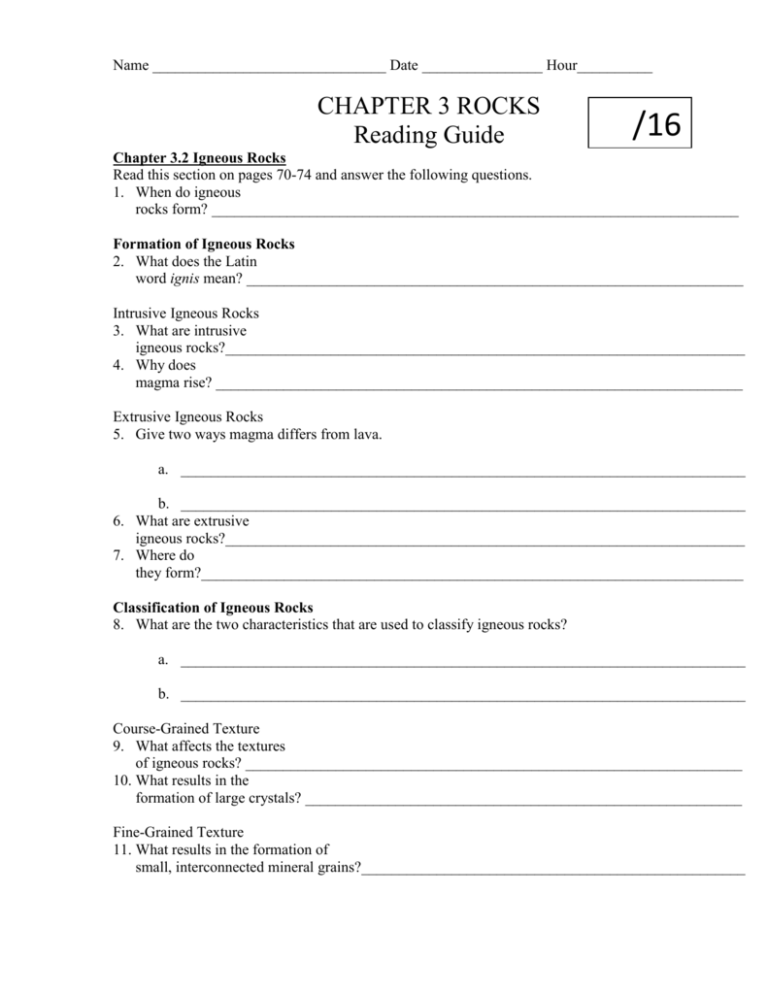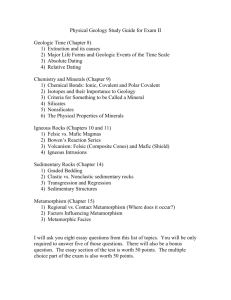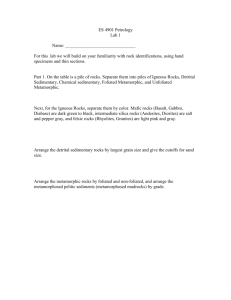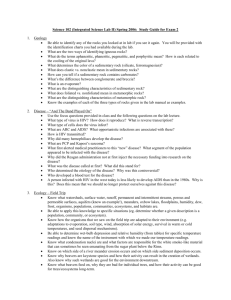Rock Reading Guide
advertisement

Name _______________________________ Date ________________ Hour__________ CHAPTER 3 ROCKS Reading Guide /16 Chapter 3.2 Igneous Rocks Read this section on pages 70-74 and answer the following questions. 1. When do igneous rocks form? ______________________________________________________________________ Formation of Igneous Rocks 2. What does the Latin word ignis mean? __________________________________________________________________ Intrusive Igneous Rocks 3. What are intrusive igneous rocks?_____________________________________________________________________ 4. Why does magma rise? ______________________________________________________________________ Extrusive Igneous Rocks 5. Give two ways magma differs from lava. a. ___________________________________________________________________________ b. ___________________________________________________________________________ 6. What are extrusive igneous rocks?_____________________________________________________________________ 7. Where do they form?________________________________________________________________________ Classification of Igneous Rocks 8. What are the two characteristics that are used to classify igneous rocks? a. ___________________________________________________________________________ b. ___________________________________________________________________________ Course-Grained Texture 9. What affects the textures of igneous rocks? __________________________________________________________________ 10. What results in the formation of large crystals? __________________________________________________________ Fine-Grained Texture 11. What results in the formation of small, interconnected mineral grains?___________________________________________________ Glassy Texture 12. What causes glassy texture? ____________________________________________________________________ Porphyritic Texture 13. What causes porphyritic textures? _______________________________________________________________ Granitic Composition (Felsic) 14. What color are these rocks? ______________________________________________________________________ 15. What are the main minerals in these rocks? _____________________________________________________________ 16. What kind of crust do these rocks make? _________________________________________________________________ Basaltic Composition (Mafic) 17. What are the main minerals in these rocks? _____________________________________________________________ 18. What elements are they rich in? ___________________________________________________________________ 19. What kind of crust do these rocks make? _______________________________________________________________ Other Compositional Groups (Intermediate) 20. How do rocks with andesitic composition compare to these other two types? _____________________________________________________ Chapter 3.3 Sedimentary Rocks Read this section on pages 75-79 and answer the following questions. 21. What are sedimentary rocks formed from? ________________________________________________________________ Formation of Sedimentary Rocks 22. When do sedimentary rocks form? ______________________________________________________________________ Weathering, Erosion, and Deposition 23. What are the two types of weathering? _______________________________________________________________ 24. What does erosion involve? ___________________________________________________________________ 25. When are sediments dropped? ________________________________________________________________ 26. What sediments are deposited first? _________________________________________________________________ Compaction and Cementation 27. What does lithified mean? ____________________________________________________________________ 28. What causes compaction? ______________________________________________________________________ 29. What cements the sediments together? ________________________________________________________________ Classification of Sedimentary Rocks 30. What are the two main groups sedimentary rocks are classified into? __________________________________________________ Clastic Sedimentary Rocks 31. What are the two most common minerals in clastic rocks? ___________________________________________________________ 32. How are clastic sedimentary rocks grouped? _________________________________________________________ 33. How do conglomerates and breccias differ? ________________________________________________________________ Chemical and Biochemical Sedimentary Rocks 34. How do chemical sedimentary rocks form? ____________________________________________________________ 35. What do biochemical sedimentary rocks contain? __________________________________________________________ Features of Some Sedimentary Rocks 36. What are unique features of sedimentary rocks clues to? __________________________________________________________ Chapter 3.4 Metamorphic Rocks Read this section on pages 80-84 and answer the following questions. 37. When do metamorphic rocks form? ___________________________________________________________ Formation of Metamorphic Rocks 38. Where are the conditions found to make metamorphic rocks? _________________________________________________________ Contact Metamorphism 39. What causes contact metamorphism? _____________________________________________________________ 40. Is this high-grade or low-grade metamorphism? ___________________________________________________________ Regional Metamorphism 41. What does regional metamorphism result in? ____________________________________________________________ Agents of Metamorphism 42. What are the three main agents of metamorphism? ___________________________________________________________ Heat 43. Heat provided the energy needed to do what? _________________________________________________________________ 44. What are the two sources of this heat? ________________________________________________________________ Pressure 45. How does pressure increase? _________________________________________________________________ 46. Pressure causes what to happen to rocks? ________________________________________________________________ Reactions in Solution 47. What are hydrothermal solutions? _____________________________________________________________ 48. How do they promote recrystallization? ___________________________________________________________ Classification of Metamorphic Rocks 49. How are metamorphic rocks classified? ___________________________________________________________________ Foliated Metamorphic Rocks 50. Some minerals recrystallize with a preferred orientation at what direction to the force? _______________________________________________ 51. How do foliated metamorphic rocks appear? __________________________________________________________ Nonfoliated Metamorphic Rocks 52. How do nonfoliated metamorphic rocks appear? __________________________________________________________







